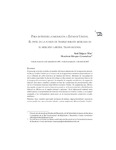
Please use this identifier to cite or link to this item:
http://ricaxcan.uaz.edu.mx/jspui/handle/20.500.11845/58Full metadata record
| DC Field | Value | Language |
|---|---|---|
| dc.contributor | 10070 | |
| dc.contributor | 102989 | |
| dc.coverage.spatial | México | es_ES |
| dc.coverage.spatial | Estados Unidos | es_ES |
| dc.creator | Delgado Wise, Raúl | |
| dc.creator | Márquez Covarrubias, Humberto | |
| dc.date.accessioned | 2017-04-17T23:41:39Z | |
| dc.date.available | 2017-04-17T23:41:39Z | |
| dc.date.issued | 2007-04-12 | |
| dc.identifier | info:eu-repo/semantics/publishedVersion | |
| dc.identifier.issn | 0301-7036 | es_ES |
| dc.identifier.uri | http://hdl.handle.net/20.500.11845/58 | |
| dc.description | This article is devoted to analyzing the new dynamism of Mexican migration to the United States in the context of the economic integration promoted by NAFTA (North American Free Trade Agreement). Using a conceptualization of the work force export model, three basic mechanisms are dissected from regional economic integration: the maquiladora, the concealed maquiladora and labor migration. This analytical framework makes it possible to review the conditions of increasing precariousness for labor on the transnational Mexico-United States horizon. It is argued that Mexico plays the role of labor reserve associated with: a) the growing precariousness and flexibility of labor in Mexico in both the formal and informal sectors; b) the wage differential between the two countries; c) the demand for cheap labor in the United States, and d) the role assigned to Mexican workers in America’s productive restructuring. | es_ES |
| dc.description.abstract | El presente artículo se dedica al análisis del nuevo dinamismo de la migración mexicana hacia Estados Unidos en el contexto de la integración económica auspiciada por el TLCAN (Tratado de Libre Comercio de América del Norte). Mediante la conceptuación del modelo exportador de fuerza de trabajo se diseccionan tres mecanismos básicos de la integración económica regional: la maquila, la maquila encubierta y la migración laboral. Este marco analítico permite revisar las condiciones de precarización laboral en el horizonte transnacional México-Estados Unidos. Se argumenta que México desempeña el papel de reserva laboral asociado a: a) la precarización y flexibilización laboral en México en el empleo formal e informal; b) el diferencial salarial entre ambos países; c) la demanda de mano de obra barata en Estados Unidos, y d) el papel asignado a los trabajadores mexicanos en la reestructuración productiva estadounidense. | es_ES |
| dc.language.iso | spa | es_ES |
| dc.publisher | Universidad Autónoma de Mexico. Instituto de Investigaciones Económicas | es_ES |
| dc.relation | http://www.revistas.unam.mx/index.php/pde/article/view/7662 | es_ES |
| dc.relation.ispartof | http://www.revistas.unam.mx/index.php/pde/issue/view/692 | es_ES |
| dc.relation.uri | generalPublic | es_ES |
| dc.rights | Attribution-NonCommercial-ShareAlike 3.0 United States | es_ES |
| dc.rights.uri | http://creativecommons.org/licenses/by-nc-sa/3.0/us/ | * |
| dc.source | Problemas del Desarrollo. Revista Latinoamericana de Economía, vol. 38, no. 249, pp. 11-34 | es_ES |
| dc.subject.classification | CIENCIAS SOCIALES [5] | es_ES |
| dc.subject.other | info:eu-repo/classification/Modelo exportador de fuerza de trabajo | |
| dc.subject.other | info:eu-repo/classification/Migración laboral | |
| dc.subject.other | info:eu-repo/classification/Reestructuración productiva | |
| dc.subject.other | info:eu-repo/classification/Precarización laboral | |
| dc.subject.other | info:eu-repo/classification/Sistema migratorio México-Estados Unidos | |
| dc.subject.other | info:eu-repo/classification/Work force export model | |
| dc.subject.other | info:eu-repo/classification/Labor migration | |
| dc.subject.other | info:eu-repo/classification/Productive restructuring | |
| dc.subject.other | info:eu-repo/classification/Labor precariousness | |
| dc.subject.other | info:eu-repo/classification/Mexico-United States migratory system | |
| dc.title | Para entender la migración a Estados Unidos. El papel de la fuerza de trabajo barata mexicana en el mercado laboral transnacional | es_ES |
| dc.type | info:eu-repo/semantics/article | es_ES |
| Appears in Collections: | *Documentos Académicos*-- UA Estudios del Desarrollo | |
Files in This Item:
| File | Description | Size | Format | |
|---|---|---|---|---|
| Delgado-Wise, Márquez Covarrubias - 2007 - Para entender la migración a Estados Unidos El papel de la fuerza de trabajo barata mexican.pdf | Versión publicada | 252,11 kB | Adobe PDF |  View/Open |
This item is licensed under a Creative Commons License
